The Effect of the Crucible on the Temperature Distribution for the Growth of a Large Size AlN Single Crystal
Abstract
:1. Introduction
2. Simulation
3. Results and Discussions
3.1. Effect of Crucible Material on Temperature Distribution
3.2. Effect of Crucible Parts on Temperature Distribution
4. Conclusions
Author Contributions
Funding
Institutional Review Board Statement
Informed Consent Statement
Data Availability Statement
Acknowledgments
Conflicts of Interest
References
- Rojo, J.C.; Schowalter, L.J.; Gaska, R. Growth and characterization of epitaxial layers on aluminum nitride substrates prepared from bulk, single crystals. J. Cryst. Growth 2002, 240, 508–512. [Google Scholar] [CrossRef]
- Hirayama, H.; Yatabe, T.; Noguchi, N. 231–261 nm AlGaN deep-ultraviolet light-emitting diodes fabricated on AlN multilayer buffers grown by ammonia pulse-flow method on sapphire. Appl. Phys. Lett. 2007, 91, 071901. [Google Scholar] [CrossRef]
- Bockowski, M. Growth and doping of GaN and AlN single crystals under high nitrogen pressure. Cryst. Res. Technol. J. Exp. Ind. Crystallogr. 2001, 36, 771–787. [Google Scholar] [CrossRef]
- Zhuang, D.; Herro, Z.G.; Schlesser, R.; Sitar, Z. Seeded growth of AlN single crystals by physical vapor transport. J. Cryst. Growth 2006, 287, 372–375. [Google Scholar] [CrossRef]
- Klein, O.; Philip, P. Transient temperature phenomena during sublimation growth of silicon carbide single crystals. J. Cryst. Growth 2003, 249, 514–522. [Google Scholar] [CrossRef]
- Slack, G.A.; McNelly, T.F. Growth of high purity AlN crystals. J. Cryst. Growth 1976, 34, 263–279. [Google Scholar] [CrossRef]
- Dryburgh, P.M. The estimation of maximum growth rate for aluminium nitride crystals grown by direct sublimation. J. Cryst. Growth 1992, 125, 65–68. [Google Scholar] [CrossRef]
- Segal, A.S.; Karpov, S.Y.; Makarov, Y.N. On mechanisms of sublimation growth of AlN bulk crystals. J. Cryst. Growth 2000, 211, 68–72. [Google Scholar] [CrossRef]
- Liu, L.; Edgar, J.H. Transport effects in the sublimation growth of aluminum nitride. J. Cryst. Growth 2000, 220, 243–253. [Google Scholar] [CrossRef]
- Bogdanov, M.V.; Karpov, S.Y.; Kulik, A.V. Experimental and Theoretical Analysis of Heat and Mass Transport in the System for AlN Bulk Crystal Growth. MRS Online Proc. Libr. (OPL) 2002, 743, 1545–1548. [Google Scholar] [CrossRef]
- Liu, L.; Edgar, J.H. A global growth rate model for aluminum nitride sublimation. J. Electrochem. Soc. 2001, 149, G12. [Google Scholar] [CrossRef]
- Wu, B.; Zhang, H. Isotropic and anisotropic growth models for the sublimation vapour transport process. Model. Simul. Mater. Sci. Eng. 2005, 13, 861. [Google Scholar] [CrossRef]
- Cai, D.; Zheng, L.; Zhang, H.; Zhuang, D.; Herro, Z.; Schlesser, R.; Sitar, Z. Effect of thermal environment evolution on AlN bulk sublimation crystal growth. J. Cryst. Growth 2007, 306, 39–46. [Google Scholar] [CrossRef]
- Lee, R.G.; Idesman, A.; Nyakiti, L. Modeling of the effects of different substrate materials on the residual thermal stresses in the aluminum nitride crystal grown by sublimation. J. Appl. Phys. 2009, 105, 033521. [Google Scholar] [CrossRef]
- Wolfson, A.A. Dependence of the growth rate of an AlN layer on nitrogen pressure in a reactor for sublimation growth of AlN crystals. Semicond. 2010, 44, 1383–1385. [Google Scholar] [CrossRef]
- Gao, B. The Impact of Pressure and Temperature on Growth Rate and Layer Uniformity in the Sublimation Growth of AlN Crystals. J. Cryst. Growth 2012, 338, 69–74. [Google Scholar] [CrossRef]
- Wang, Q.K. Influence of Crucible Shape on Mass Transport in AlN Crystal Growth by Physical Vapor Transport Process. J. Cryst. Growth 2019, 515, 21–25. [Google Scholar] [CrossRef]
- Wang, Q.K. Optimization of Total Resolved Shear Stress in AlN Single Crystals Homoepitaxially Grown by Physical Vapor Transport Method. J. Cryst. Growth 2019, 519, 14–19. [Google Scholar] [CrossRef]
- Dupret, F.; Nicodeme, P.; Ryckmans, Y.; Wouters, P.; Crochet, M. Global modelling of heat transfer in crystal growth furnaces. Int. J. Heat Mass Transf. 1990, 33, 1849–1871. [Google Scholar] [CrossRef]
- Chen, Q.S.; Zhang, H.; Prasad, V.; Balkas, C.M.; Yushin, N.K. Modeling of heat transfer and kinetics of physical vapor transport growth of silicon carbide crystals. J. Heat Transf. 2001, 123, 1098–1109. [Google Scholar] [CrossRef]
- Wang, Z.; Deng, X.; Cao, K.; Wang, J.; Wu, L. Hotzone design and optimization for 2-in. AlN PVT growth process through global heat transfer modeling and simulations. J. Cryst. Growth 2017, 474, 76–80. [Google Scholar] [CrossRef]
- Li, H.; Liu, X.; Feng, Y.; Wei, H.; Yang, S. Numerical study of radial temperature distribution in the AlN sublimation growth system. Cryst. Res. Technol. 2013, 48, 321–327. [Google Scholar] [CrossRef]
- Toth, L. (Ed.) Transition Metal Carbides and Nitrides; Elsevier: Amsterdam, The Netherlands, 1971; Volume 1, pp. 145–148. [Google Scholar]
- Miyazaki, N. Thermal Stress Analysis of Silicon Bulk Single Crystal during Czochralski Growth. J. Cryst. Growth 1992, 125, 102–111. [Google Scholar] [CrossRef]
- Jordan, A.S.; Caruso, R.; VonNeida, A.R. A comparative study of thermal stress induced dislocation generation in pulled GaAs, InP, and Si crystals. J. Appl. Phys. 1981, 52, 3331–3336. [Google Scholar] [CrossRef]
- Kamitani, K. The Elastic Constants of Silicon Carbide: ABrillouin-Scattering Study of, 4.H.; 6HSiCSingle Crystals. J. Appl. Phys. 1997, 82, 3152–3154. [Google Scholar] [CrossRef]
- Ma, R.; Zhang, H.; Ha, S.; Skowronski, M. Integrated process modeling and experimental validation of silicon carbide sublimation growth. J. Cryst. Growth 2003, 252, 523–537. [Google Scholar] [CrossRef]
- Liu, B.; Edgar, J.H.; Gu, Z. The durability of various crucible materials for aluminum nitride crystal growth by sublimation. Mater. Res. Soc. Internet J. Nitride Semicond. Res. 2004, 9, 6. [Google Scholar] [CrossRef] [Green Version]
- Schlesser, R.; Dalmau, R.; Zhuang, D. Crucible materials for growth of aluminum nitride crystals. J. Cryst. Growth 2005, 281, 75–80. [Google Scholar] [CrossRef]
- Noveski, V. Mass Transfer in AlNCrystal Growth at High Temperatures. J. Cryst. Growth 2004, 264, 369–378. [Google Scholar] [CrossRef]
- Selder, M. Global Modeling of the SiC Sublimation Growth Process: Prediction of Thermoelastic Stress Control of Growth Conditions. J. Cryst. Growth 2001, 226, 501–510. [Google Scholar] [CrossRef]

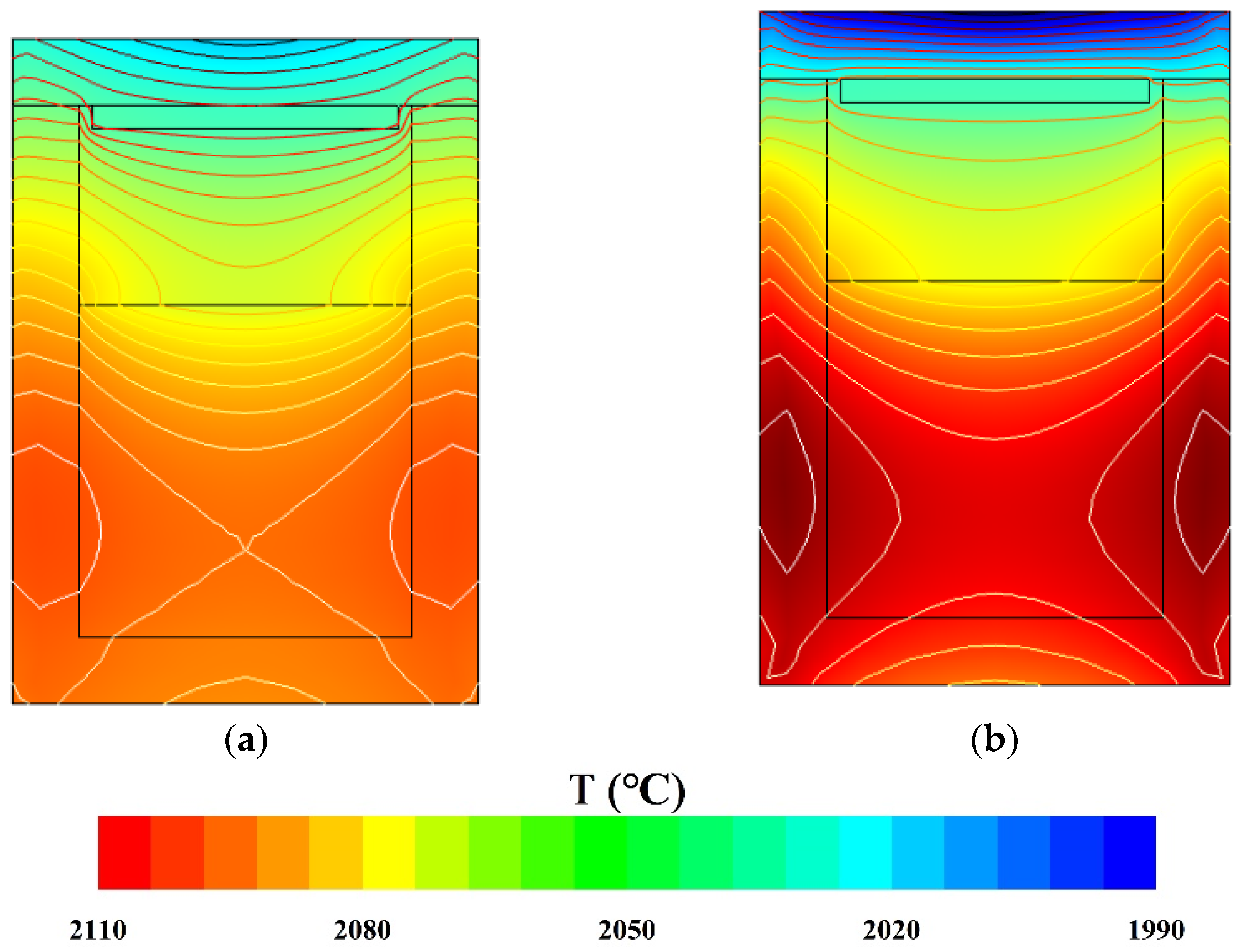

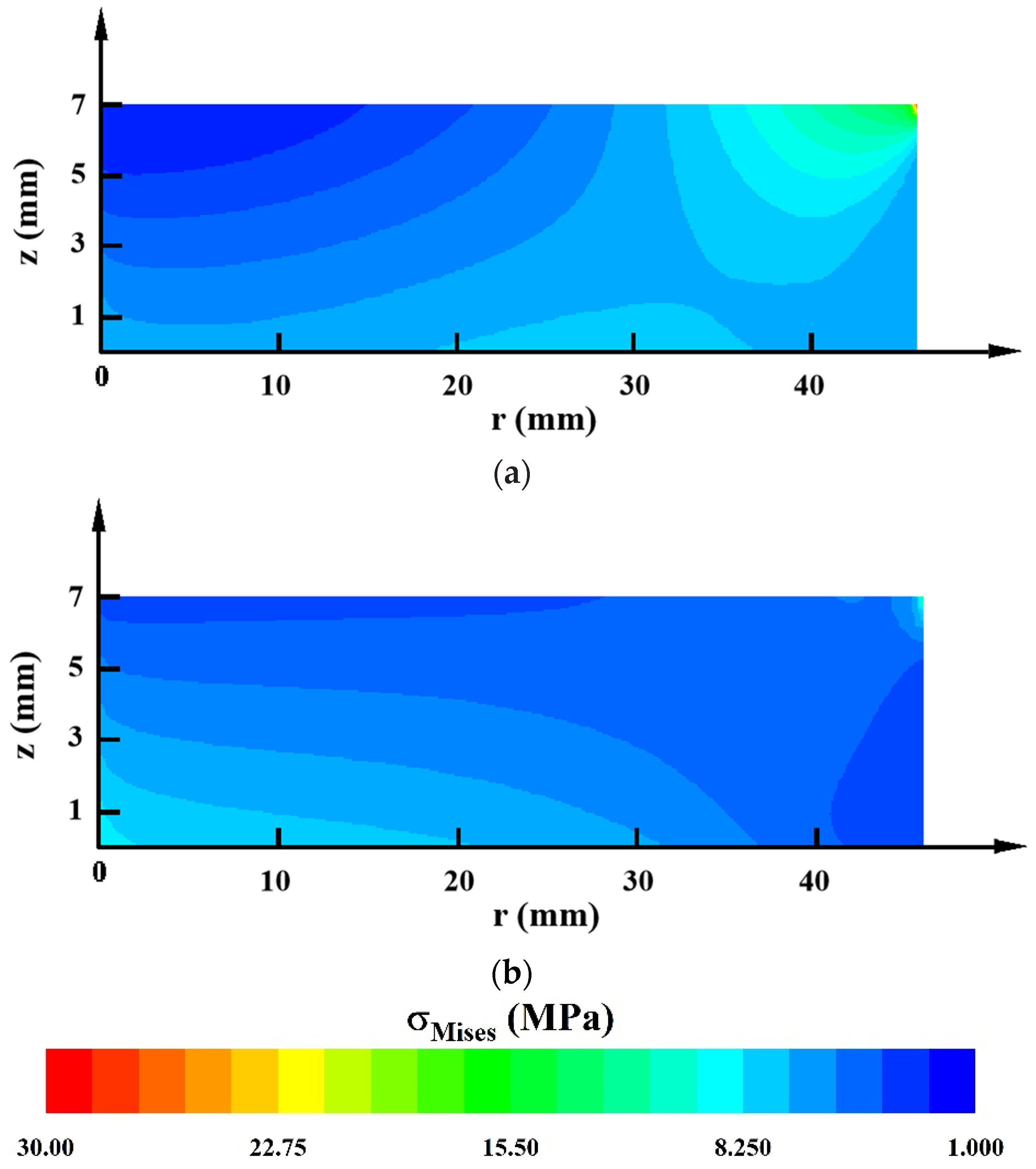
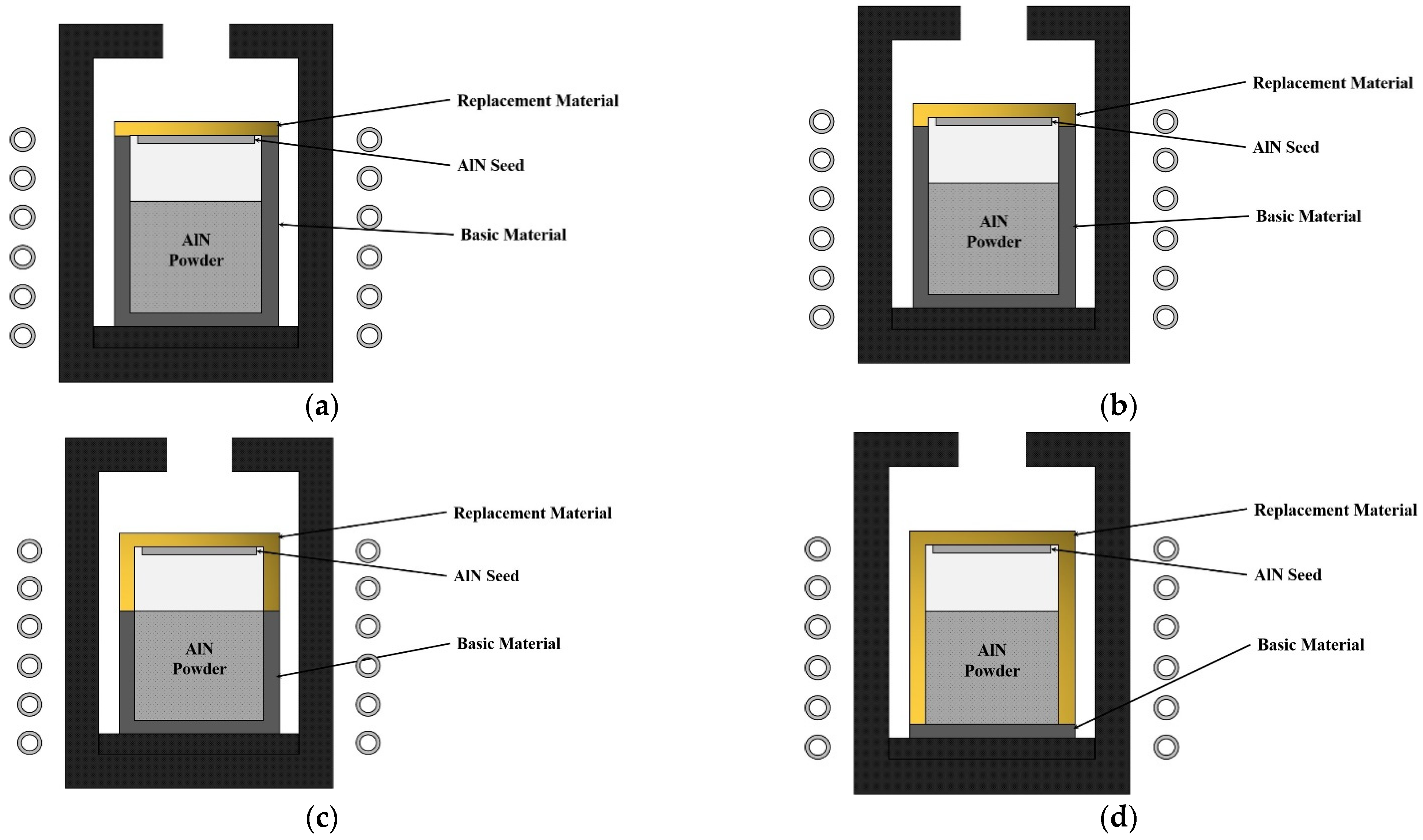
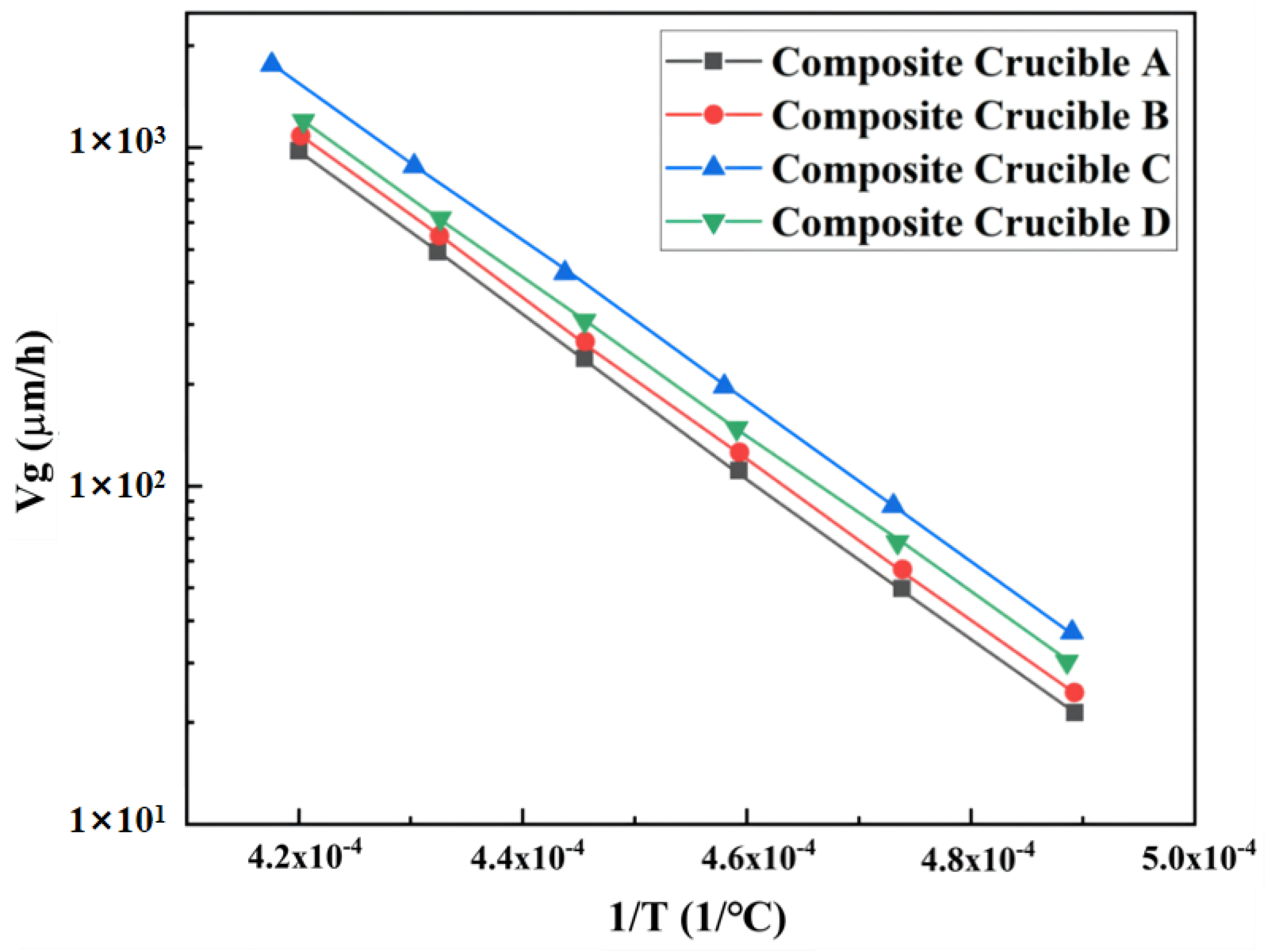
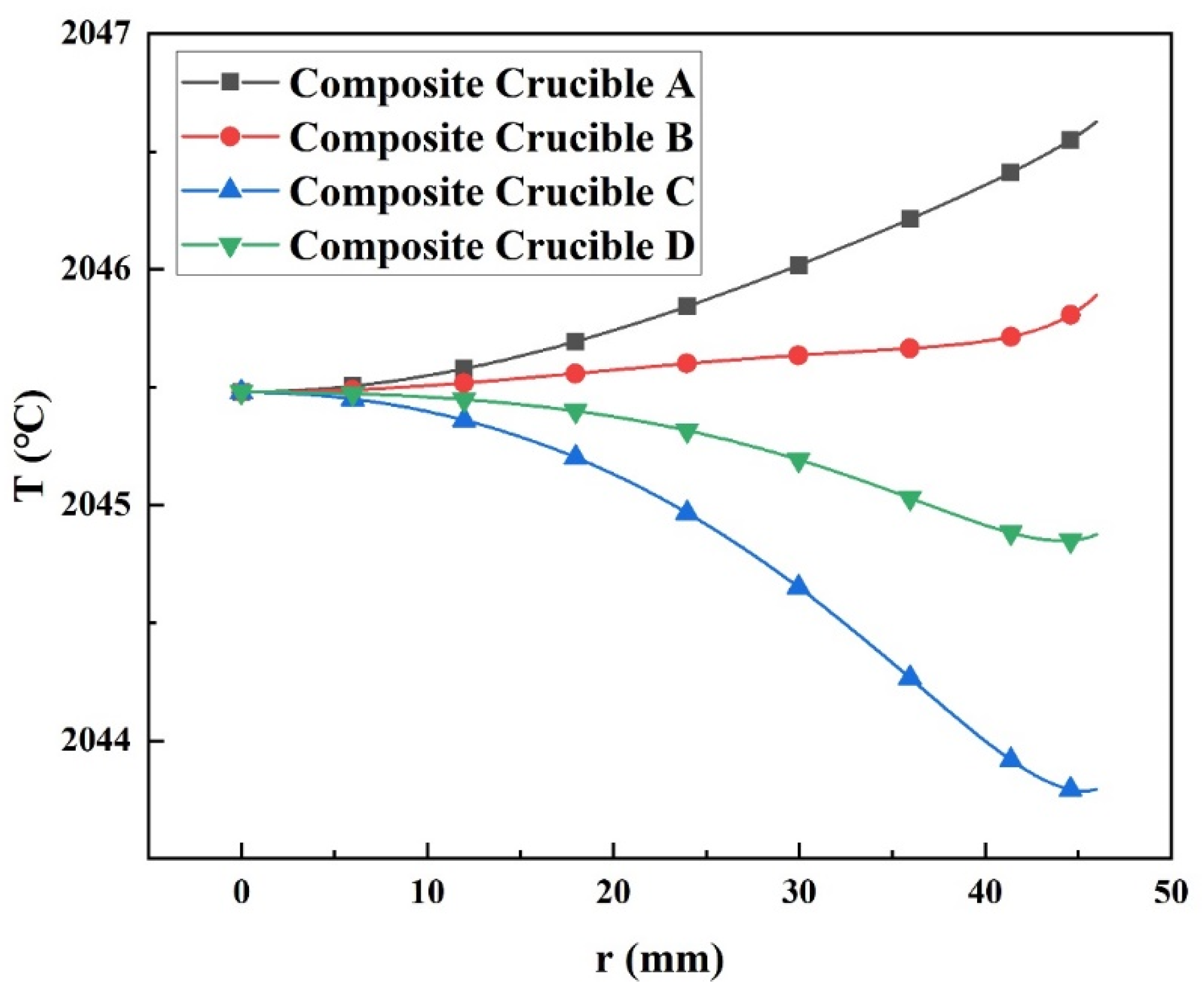
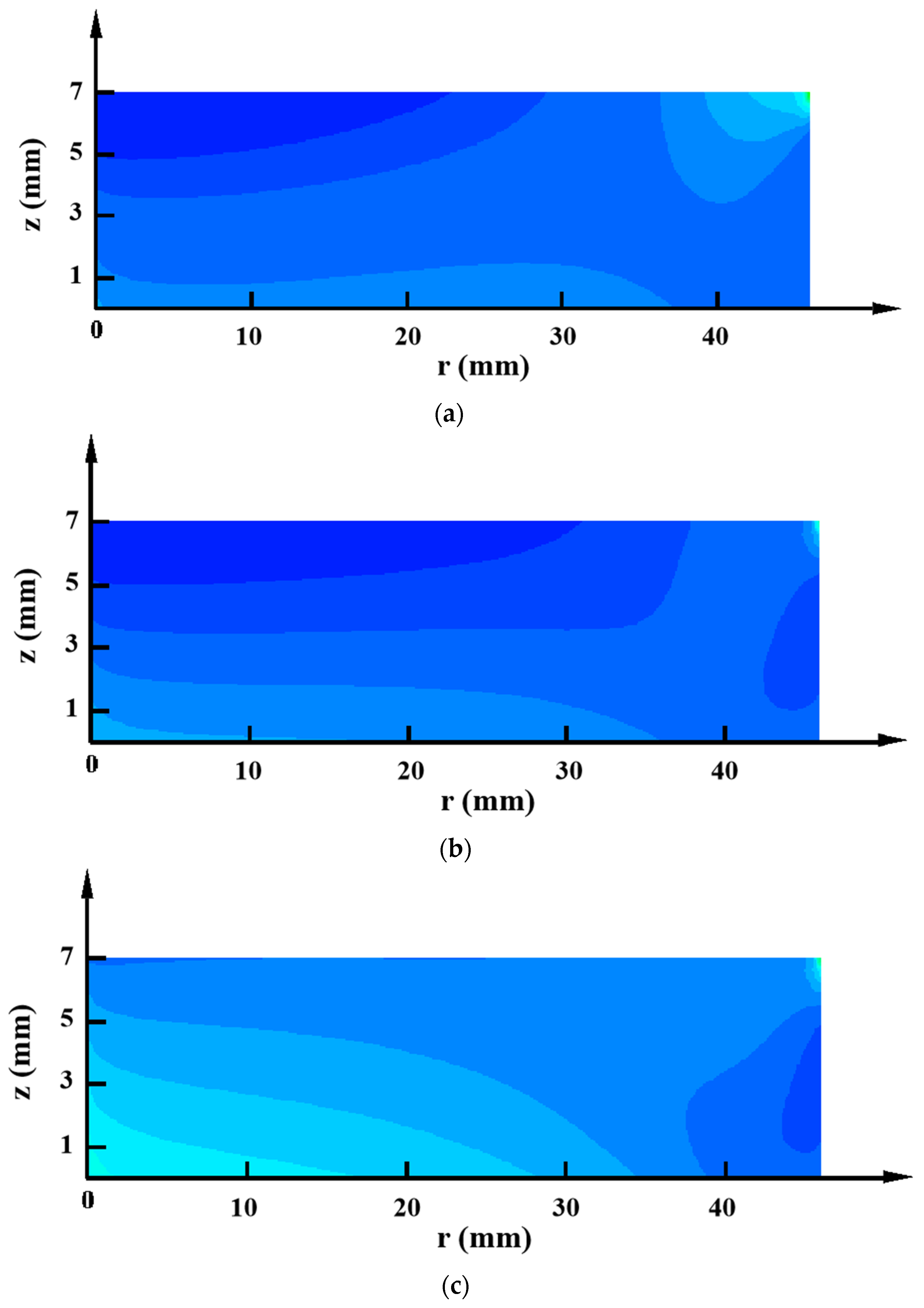
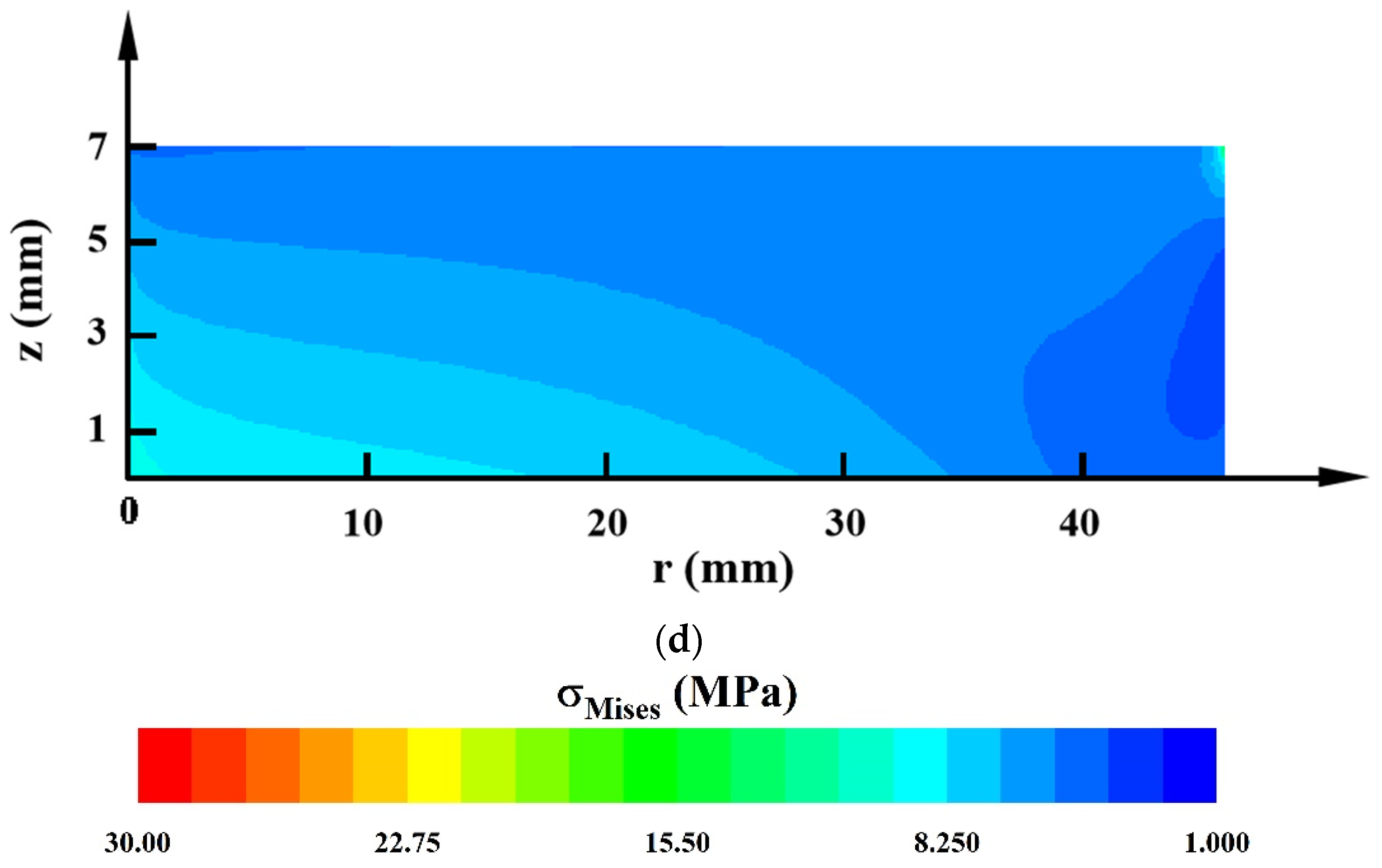
| Material | Thermal Conductivity (W/m·K) | Density (kg/m3) | Heat Capacity (J/kg·K) |
|---|---|---|---|
| Graphite Crucible | 115 | 1760 | 720 |
| TaC Crucible | 22 | 14,300 | 60.65 |
| Insulation | 0.5 | 170 | 2100 |
| AlN powder | 22.55 | 27, 0.34 | 11, 72.7 |
| AlN seed | 320 | 3250 | 1197 |
Publisher’s Note: MDPI stays neutral with regard to jurisdictional claims in published maps and institutional affiliations. |
© 2021 by the authors. Licensee MDPI, Basel, Switzerland. This article is an open access article distributed under the terms and conditions of the Creative Commons Attribution (CC BY) license (https://creativecommons.org/licenses/by/4.0/).
Share and Cite
Yu, Y.; Liu, B.; Tang, X.; Song, B.; Han, P.; Liu, S.; Gao, B. The Effect of the Crucible on the Temperature Distribution for the Growth of a Large Size AlN Single Crystal. Materials 2022, 15, 54. https://doi.org/10.3390/ma15010054
Yu Y, Liu B, Tang X, Song B, Han P, Liu S, Gao B. The Effect of the Crucible on the Temperature Distribution for the Growth of a Large Size AlN Single Crystal. Materials. 2022; 15(1):54. https://doi.org/10.3390/ma15010054
Chicago/Turabian StyleYu, Yue, Botao Liu, Xia Tang, Botao Song, Pengfei Han, Sheng Liu, and Bing Gao. 2022. "The Effect of the Crucible on the Temperature Distribution for the Growth of a Large Size AlN Single Crystal" Materials 15, no. 1: 54. https://doi.org/10.3390/ma15010054
APA StyleYu, Y., Liu, B., Tang, X., Song, B., Han, P., Liu, S., & Gao, B. (2022). The Effect of the Crucible on the Temperature Distribution for the Growth of a Large Size AlN Single Crystal. Materials, 15(1), 54. https://doi.org/10.3390/ma15010054








